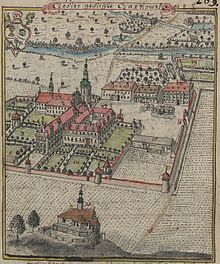Czarnowanz
| Czarnowanz Czarnowąsy |
||
|---|---|---|

|
|
|
| Basic data | ||
| State : | Poland | |
| Voivodeship : | Opole | |
| Powiat : | District-free city | |
| District of: | Opole | |
| Geographic location : | 50 ° 44 ' N , 17 ° 54' E | |
| Residents : | 3108 | |
| Postal code : | 46-020 | |
| Telephone code : | (+48) 77 | |
| Economy and Transport | ||
| Street : | Ext. 454 | |
| Rail route : | Opole-Jelcz-Laskowice | |
| Next international airport : | Wroclaw | |
| Katowice-Pyrzowice | ||
Czarnowanz (Polish: Czarnowąsy ) is a district of the city of Opole . Until 2016, the Upper Silesian village was in the rural municipality of Groß Döbern ( Dobrzeń Wielki ) in the Powiat Opolski (Opole district).
geography
Geographical location
Czarnowanz is seven kilometers southeast of the former town hall of Groß Döbern . The Malapane runs through the village in the north and the Swornica in the northwest . To the west of the settlement area is the Oder . Droga wojewódzka 454 road runs through the village .
Neighboring communities
Neighboring towns of Czarnowanz are in the northwest Borrek (Polish: Borki ), in the north Horst (Polish Świerkle ), in the east Biadacz and in the south the Opole district Wróblin (German Frauendorf ). To the north of the village is the Elektrowina Opole power station .
history
The first written mention of Dobren (Groß Döbern) and Charnovanz comes from the year 1228, in connection with the relocation of the Norbertine convent from Rybnik to Czarnowanz by the Opole duke Casimir I. While Kasimir handed over the towns of Klein Döbern and Czarnowanz to the monastery, Groß stayed Döbern ducal property.
In 1845 the village had 150 houses, including the monastery church of St. Norbert, the scrap wood church of St. Anna, the monastery building and several outbuildings. In the same year the place had 1,143 inhabitants, of which 18 were Protestant and 27 were Jewish.
In the referendum in Upper Silesia on March 20, 1921, 779 voters voted to remain with Germany and 376 for Poland, in the manor district of Czarnowanz 58 people voted for Germany and four for Poland. Czarnowanz remained with the German Empire . In 1933 there were 2676 inhabitants. On August 10, 1936, the place was renamed Klosterbrück . In 1939 the place had 3528 inhabitants. Until 1945 the place was in the district of Opole .
In 1945 the previously German place came under Polish administration and was renamed Czarnowąsy and joined the Silesian Voivodeship. In 1950 the place came to the Opole Voivodeship . In 1999 the place came to the re-established Powiat Opolski . On April 22, 2009, German was introduced as the second official language in the municipality of Groß Döbern, to which Czarnowanz belongs, and on December 1, 2009, the place was also given the official German place name Czarnowanz .
On January 1, 2017, Czarnowanz was incorporated into the city of Opole.
Etymology of the place name
The name of the place is derived from the Polish place name Czarnowasy . This translates to black beard .
Population development
|
|
Attractions
St. Anne's Church
The baroque scrap wood church of St. Anna was built between 1684 and 1688 on the southern edge of Czarnowanz on a hill. The church burned down completely on the night of August 19-20, 2005 and was then reconstructed and rebuilt again until 2007. The Czarnowanz cemetery is located around the church.
St. Norbert
The beginnings of the Church of St. Norbert date back to the 13th century. This first church was burned down and destroyed by the Swedes in 1643 during the Thirty Years War. A few years later it was rebuilt and rebuilt in its current baroque form in 1777.
Premonstratensian monastery
Today's baroque Premonstratensian monastery dates back to 1682. The first monastery complex was built in the 13th century and was destroyed in the Thirty Years' War in 1642/43. The complex has been a listed building since 1964.
Sons and daughters of the place
- Franz Wosnitza (1902–1979), priest, 1942–1945 Vicar General in Katowice, promoter of German-Polish reconciliation
- Dietmar Wolter (* 1941), German surgeon, inventor and entrepreneur
- Sylvia Kollek (* 1970), German marketing manager
- Norbert Rasch (* 1971), German politician and musician, Chairman of the Social-Cultural Society of Germans in Opole Silesia
Web links
- History of the community of Groß Döbern ( Memento from March 17, 2007 in the Internet Archive )
Individual evidence
- ^ History of the Czarnowanz Monastery
- ^ Johann Georg Knie: Alphabetical-statistical-topographical overview of the villages, spots, cities and other places of the royal family. Preuss. Province of Silesia. Breslau 1845, p. 84.
- ↑ See results of the referendum in Upper Silesia of 1921 ( Memento of January 24, 2017 in the Internet Archive )
- ↑ Gazeta Wyborcza: http://opole.wyborcza.pl/opole/1,35114,20423849,wieksze-opole-rzad-zatwierdzil-poszerzenie-granic-miasta.html
- ^ Sejm: Ordinance of January 1, 2017
- ^ Heinrich Adamy : The Silesian place names, their origin and meaning - A picture from prehistory , Breslau, Priebatsch, 1889, p. 10
- ^ Max Friederichsen: Contributions to the Silesian regional studies. XXI Geographers' Day 1925. p. 68
- ↑ Michael Rademacher: German administrative history from the unification of the empire in 1871 to the reunification in 1990. City and district of Opole (Polish: Opole). (Online material for the dissertation, Osnabrück 2006).
- ^ Józef Madeja: Powiat opolski. Szkice monograficzne. Opole: Instytut Śląski w Opolu, 1969, s. 335.
- ↑ Urząd Gminy Dobrzeń Wielki: Strategia Rzwoju Gminy Dobrzeń Wielki. 2007. p. 47
- ^ Location of the municipality and its division into administrative areas
- ↑ History of St. Anne's Church (Polish)
- ^ History of St. Norbert (Polish)
- ↑ History of the monastery complex (Polish)
- ^ Monument topology Opole Voivodeship





